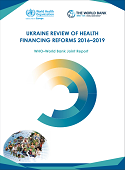Ukraine: review of health financing reforms 2016–2019 (2019)

Download
WHO - World Bank Joint Report
In 2015, the Government of Ukraine initiated transformative reforms of its health system to improve population health outcomes and ensure financial protection from excessive out-of-pocket payments. This was to be achieved through increasing efficiency, modernizing the obsolete service delivery system and improving access to better quality of care.
This report is based on a joint WHO–World Bank review carried out in April–July 2019 looking at progress implementing health financing reforms in Ukraine towards these objectives. It concludes that the overall design of Ukraine’s health financing reforms is in line with international good practices to improve access, quality and efficiency of health services. Implementation has successfully moved forward, the National Health Service of Ukraine has been established as a critical change agent and tangible benefits are beginning to emerge in primary health care. However, serious challenges are on the horizon. Ukraine’s overall macro-fiscal environment remains difficult.
As a result, efficiency gains, particularly via hospital restructuring, will be key to demonstrate results from the reforms. Ensuring overall stability of the health budget envelope and prioritizing public health (health promotion and disease prevention) and primary health care will be essential to ensure improved frontline services. Local governments have an important role to play as facility owners and financing agents, but further policy dialogue is needed to align decentralized roles and national health policy priorities. Building distributed ownership for the reforms among key stakeholders including local governments, providers and the population is important for sustainability. With consistent implementation and careful policy dialogue, these challenges can be overcome and the reforms can be expected to yield tangible benefits in terms of improved health outcomes and reduced financial burden for the population in coming years.



